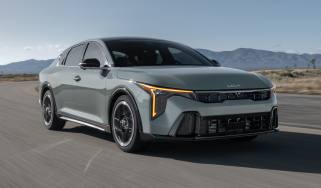Renaultsport Twingo 133
City baby grows up – but can it take on the big boys?
F there’s one company that knows how to build a hot hatch, then it’s Renault. In the past, the firm has given us the fiery 5 GT Turbo and sublime Clio Williams, while today’s Clio Cup continues the brand’s pocket rocket success story.
And there’s every reason to expect that the latest Twingo has what it takes to join this illustrious line-up, as it has been developed by the brand’s legendary Renaultsport division in Dieppe, Paris. Not only is this outfit responsible for the excellent Clio 197 and Mégane R26, it also builds the engines which power Fernando Alonso’s Formula One car.
Despite this, the Renault misses out on pole position here when it comes to styling. The cute looks of the standard car have been beefed up with chunky wheelarches, sill extensions and spoilers. Sadly, all these additions have a distinctly aftermarket feel.
It’s the same story when you climb aboard. Heavily bolstered sports seats, a thick-rimmed three-spoke steering wheel and red belts help give the cabin a sporty edge, but the Twingo can’t match its rival for fit and finish. The plastics used for the dash are hard and scratchy, while the rest of the interior lacks the solid feel of the Suzuki. The Renault does score on versatility, though. As with other Twingo models, it gets two rear seats that slide independently – increasing either luggage capacity or legroom. And with them folded flat, there’s a useful 959 litres of load space – much more than the 435 litres offered by the Japanese car.
But these two challengers are as much about performance as practicality. Initial impressions are good, because the Renault’s 131bhp 1.6-litre unit feels eager and has a tuneful exhaust note.
However, at the test track it sprinted from 0-60mph in nine seconds dead – two-tenths of a second slower than the aptly named Swift – while its gearshift action lacked the mechanical precision of the Suzuki’s. Get out on your favourite back road, however, and the Renault is more than a match for its competitor. The on-paper performance deficit is barely noticeable, with the Twingo pulling strongly all the way to its 7,000rpm red line.
Our car was fitted with the optional Cup chassis, which helps to sharpen up the driving dynamics. For £650 it adds stylish graphite grey 17-inch alloy wheels, together with 10 per cent stiffer springs and a 4mm reduced ride height. At low speeds you have to put up with an extremely firm ride, but turn into a sharp bend and the Twingo responds instantly, gripping hard and displaying cast-iron body control. And while the electrically assisted steering lacks feel, it is direct and well weighted.
So, is the Renault’s slight advantage in driving dynamics enough to give it victory over the Suzuki? Read on...
Details
Price: £12,200
Model tested: Renaultsport Twingo 133
Chart position: 2
WHY: Racy Renaultsport makeover aims to revive the lacklustre Twingo line-up.
Economy
Sticking to the standard Twingo spec means you’ll pay £365 less than the Swift. The Cup chassis option is a must, though, and pushes the Renault £285 ahead of its rival. However, while it isn’t as well equipped as the Suzuki, it’s not exactly lacking kit – auto wipers and lights are standard, while cruise control is a useful option. It should also prove slightly cheaper to run, with lower servicing costs and longer intervals between routine stops. At 165g/km, the Twingo’s CO2 emissions drop it into a lower tax band, although the 28.8mpg economy we achieved is disappointing for such a light car.







